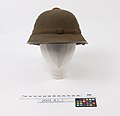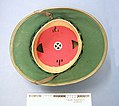File:Nazi Germany WWII Deutsches Afrikakorps DAK Tropenhelm Wehrmacht Heer Army tropical pith helmet Eagle-and-swastika insignia national emblem Tøjhusmuseet National Museum Denmark THM-24185 CC-BY-SA.jpg

Size of this preview: 800 × 502 pixels. Other resolutions: 320 × 201 pixels | 640 × 402 pixels | 1,024 × 643 pixels | 1,280 × 804 pixels | 2,560 × 1,607 pixels | 4,455 × 2,797 pixels.
Original file (4,455 × 2,797 pixels, file size: 906 KB, MIME type: image/jpeg)
File information
Structured data
Captions
Captions
Add a one-line explanation of what this file represents
Summary edit
| DescriptionNazi Germany WWII Deutsches Afrikakorps DAK Tropenhelm Wehrmacht Heer Army tropical pith helmet Eagle-and-swastika insignia national emblem Tøjhusmuseet National Museum Denmark THM-24185 CC-BY-SA.jpg |
Dansk: Tøjhusmuseet: Tropehjelm for det tyske Afrikakorps, 1940-43.
Brunt filt og med en ret bred skygge hele vejen rundt. Fortil er den seks komma fem centimeter bred og bliver derefter smallere ved siderne for at skråne ud bagtil, hvor den er otte komma seks centimeter bred. Ovenpå pulden en ventilationsknap, der kan drejes. Skyggen kantet med en smal læderkant. En en komma fem centimeter bred grå læderrem, der kan justeres, går fra indersiden henover skyggen foran. Remmen kan hægtes af i den ene side. På højre side af hjelmen sidder et fire centimeter højt metalskjold i sort, sølv og rødt. (infanteri). På venstre side sidder et lignende skjold med den tyske rigsørn stående på hagekorset i sølv, bunden er sort (højhestegn). Det inderste filtlag er rødt med huller for ventilation. Linningen er af gult læder. Undersiden af skyggen er foret med mørkegrønt bomuld.
English: Tropical pith helmet (German: Tropenhelm) used by the German Afrika Korps (Deutsches Afrikakorps, DAK) with Nazi Germany's national and military insignia on decals, featuring the eagle-and-swastika emblem of the German army (Wehrmachtsadler, "armed forces eagle") and the national colours.
|
| Date | 1940–1945 |
| Source | https://samlinger.natmus.dk/thm/object/23174 |
| Author | Photo of military headgear in the collections of the Danish War Museum (Danish: Tøjhusmuseet); National Museum of Denmark, Copenhagen (Nationalmuseet, Danmark); CC-BY-SA |
| Other versions |
|
Licensing edit
This file is licensed under the Creative Commons Attribution-Share Alike 4.0 International license.
- You are free:
- to share – to copy, distribute and transmit the work
- to remix – to adapt the work
- Under the following conditions:
- attribution – You must give appropriate credit, provide a link to the license, and indicate if changes were made. You may do so in any reasonable manner, but not in any way that suggests the licensor endorses you or your use.
- share alike – If you remix, transform, or build upon the material, you must distribute your contributions under the same or compatible license as the original.

|
Legal disclaimer This image shows (or resembles) a symbol that was used by the National Socialist (NSDAP/Nazi) government of Germany or an organization closely associated to it, or another party which has been banned by the Federal Constitutional Court of Germany. The use of insignia of organizations that have been banned in Germany (like the Nazi swastika or the arrow cross) may also be illegal in Austria, Hungary, Poland, Czech Republic, France, Brazil, Israel, Ukraine, Russia and other countries, depending on context. In Germany, the applicable law is paragraph 86a of the criminal code (StGB), in Poland – Art. 256 of the criminal code (Dz.U. 1997 nr 88 poz. 553). |
File history
Click on a date/time to view the file as it appeared at that time.
| Date/Time | Thumbnail | Dimensions | User | Comment | |
|---|---|---|---|---|---|
| current | 23:38, 11 October 2023 |  | 4,455 × 2,797 (906 KB) | Wolfmann (talk | contribs) | Uploaded a work by Photo of military headgear in the collections of the Danish War Museum (Danish: ''Tøjhusmuseet''); National Museum of Denmark, Copenhagen (''da:Nationalmuseet, Danmark''); en:CC-BY-SA from https://samlinger.natmus.dk/thm/object/23174 with UploadWizard |
You cannot overwrite this file.
File usage on Commons
The following 3 pages use this file:
- File:Nazi Germany WWII Deutsches Afrikakorps DAK Tropenhelm Wehrmacht Heer Army tropical pith helmet Eagle-and-swastika insignia national emblem Tøjhusmuseet National Museum Denmark THM-24184 CC-BY-SA.jpg
- File:Nazi Germany WWII Deutsches Afrikakorps DAK Tropenhelm Wehrmacht Heer Army tropical pith helmet Eagle-and-swastika insignia national emblem Tøjhusmuseet National Museum Denmark THM-24185 CC-BY-SA.jpg
- File:Nazi Germany WWII Deutsches Afrikakorps DAK Tropenhelm Wehrmacht Heer Army tropical pith helmet Eagle-and-swastika insignia national emblem Tøjhusmuseet National Museum Denmark THM-24186 CC-BY-SA.jpg
















